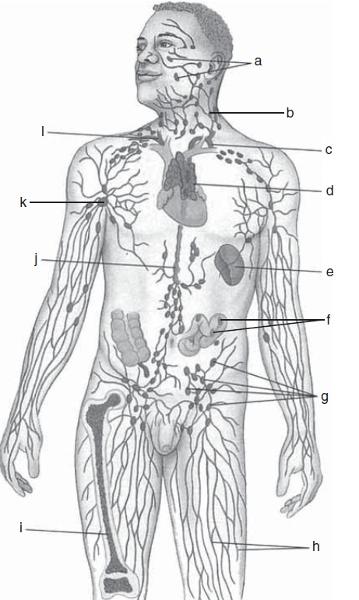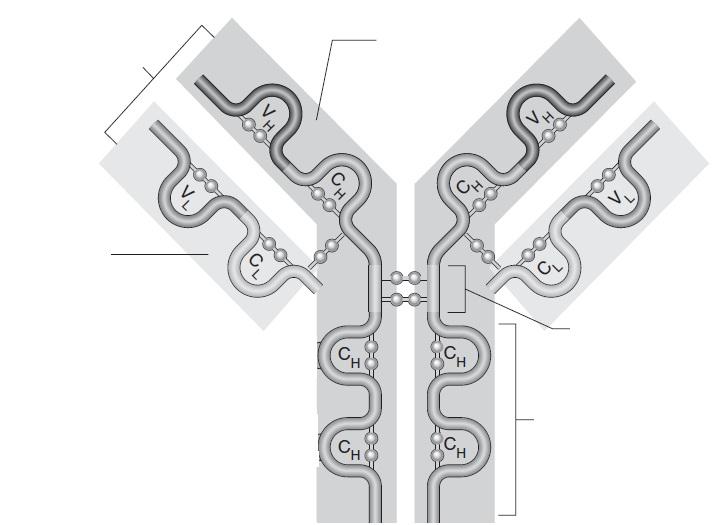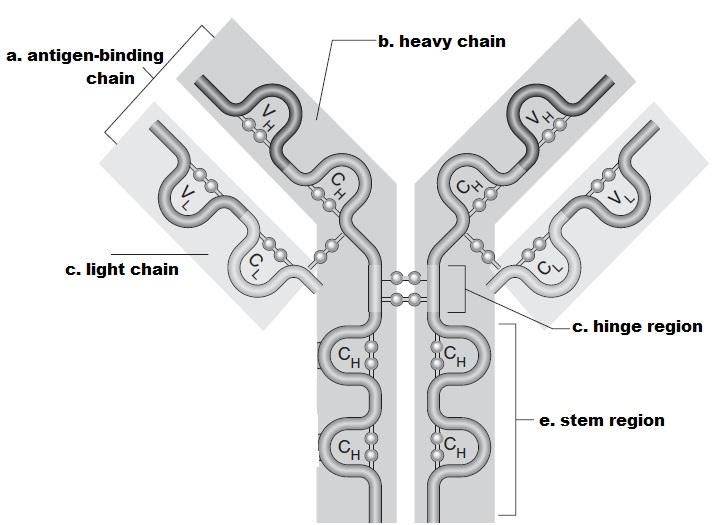Instructions for Side by Side Printing
- Print the notecards
- Fold each page in half along the solid vertical line
- Cut out the notecards by cutting along each horizontal dotted line
- Optional: Glue, tape or staple the ends of each notecard together
Exercise 35A: The Lymphatic System and Immune System
front 1  Match the terms with the correct letters in the diagram. | back 1 A. TONSILS
|
front 2 Explain why the lymphatic system is a one-way system, whereas the blood vascular system is a two-way system. | back 2 Blood vessels form a complete circuit from and to the heart. The lymphatic system lacks arteries and begins with blind-ended lymph capillaries. Thus, it is a "return" system only. |
front 3 How do lymphatic vessels resemble veins? | back 3 The lymphatic collecting vessels have three tunics and are equipped with valves. |
front 4 How do lymphatic capillaries differ from blood capillaries? | back 4 Blood capillaries carry blood from small arterioles to small venules.
|
front 5 What is the function of the lymphatic vessels? | back 5 Lymphatic vessels carry lymph from peripheral tissues to the venous system. The lymphatic system transports lymphocytes, is involved in the removal of foreign matter & cell debris by phagocytes & is part of the body's immune system. It also transports fats from the small intestine to the blood. |
front 6 What is lymph? | back 6 Lymph is a clear to yellowish watery fluid which is found throughout the body. It circulates through body tissues picking up fats, bacteria, and other unwanted materials, filtering these substances out through the lymphatic system; a thin coagulable fluid (similar to plasma but) containing white blood cells (lymphocytes) and chyle |
front 7 What factors are involved in the flow of lymphatic fluid? | back 7 The milking action of the skeletal muscles and on pressure changes within the thorax that occur during breathing. |
front 8 What name is given to the terminal duct draining most of the body? | back 8 thoracic duct |
front 9 What is cisterna chyli? | back 9 Enlarged terminus of the thoracic duct that receives lymph from the digestive viscera. |
front 10 How does the composition of lymph in the cisterna chyli differ from that in the general lymphatic stream? | back 10 They are the same except that the lymph in the cisterna chyli is very fat-rich |
front 11 Which portion of the body is drained by the right lymphatic duct? | back 11 right upper extremity, head and thorax |
front 12 Note three areas where lymph nodes are densely clustered: _____________, ______________, and ______________. | back 12 inguinal, axillary, and cervical regions of the body. |
front 13 What are the two major functions of the lymph nodes? _________________________________ and _______________________________. | back 13 filtering and protection |
front 14 The radical mastectomy is an operation in which a cancerous breast, surrounding tissues, and the underlying muscles of the anterior thoracic wall, plus the axillary lymph nodes, are removed. After such an operation, the arm usually swells, or becomes edematous, and is very uncomfortable -- sometimes for months. Why? | back 14 The lymphatic fluid is not being drained from the area due to a disruption of lymphatic vessels and nodes. |
front 15 What is the function of B cells in the immune response? | back 15 B cells differentiate into plasma cells that secrete antibodies. Antibodies are proteins that bind to specific antigens and mark them for destruction. They provide humoral immunity. |
front 16 What is the role of T cells? | back 16 directly attack virus-infected tissue cells, some help activate the B cells and cytotoxic T cells, and others can inhibit the immune response. They provide cellular immunity. |
front 17 Define the following term related to the operation of the immune system.
| back 17 when the immunity system has/stores a memory from a previously encountered foreign antibody. |
front 18 Define the following term related to the operation of the immune system.
| back 18 the quality of having a certain action, reacting only with certain substances, as antibodies with certain antigens (antigen specificity). Like B cells with antibodies. |
front 19 Define the following term related to the operation of the immune system.
| back 19 Self recognition immunity is when something goes into the body and it has been there before. The body automatically puts a marker specific to only that substance on it so that anytime it is in contact with the body it will recognize it. Non-recognized immunity is when a foreign substance enters the body. In this case the body has defense teams designed to attack and rid the body of the foreign substance. |
front 20 Define the following term related to the operation of the immune system.
| back 20 When the immune system attacks the body (doesn't recognize a body tissue, identifies it as foreign) |
front 21 What structural characteristic ensures a slow flow of lymph through a lymph node? Why is this desirable? | back 21 each lymph node has fewer efferent than afferent vessels, so the lymph flow stagnates somewhat within the node; this is desirable because it allows time for the generation of an immune response and for the macrophages to remove debris from the lymph before it reenters the blood vascular system |
front 22 What similarities in structure and function are found in the lymph nodes, spleen, and tonsils? | back 22 Structurally:
|
front 23 Distinguish between antigen and antibody. | back 23 Antigens are substances that provoke an immune response (they're the ultimate target for the immune system). Antibodies are simply proteins that are secreted as a result of the antigen provoked immune response. In short, antigens cause the disease and antibodies cure it. |
front 24 Describe the structure of the immunoglobulin monomer. | back 24 Each monomer is composed of four protein chains(two heavy chains and two light chains) connected by disulfide bonds. both the heavy and light chains have regions of constnt amino acid sequence (c regions) and regions of variable amino acid sequence (v regions). The variable regions differ in each type of antibody and construct the antigen-binding sites. Each immunoglobulin monomer has two such antigen-specific sites. |
front 25  | back 25  |
front 26 Are the genes coding for one antibody entirely different from those coding for a different antibody? Explain your answer. | back 26 no, not entirely. Each antibody (Immunoglobulin, "Ig") has both 2 constant regions referred to as "heavy hains" and 2 variable regions referred to as "light chains". The structure of the heavy chains remain the same between the different antibody structures. However, the light chains differ in structure enabling them to respond differently to different specific antigens introduced to the cellular membrane. |
front 27 In the Ouchterlony test, what happened when the antibody to horse serum albumin mixed with horse serum anbumin? | back 27 You will get an antibody-antigen reaction. If on a solid phase, like an Ouchterlony agarose gel you will see a white precipitin line. If in a liquid, like in a test tube, you will see a white precipitate. |
front 28 If the unknown antigen contained bovine and swine serum albumin, what would you expect to happen in the Ouchterlony test, and why? | back 28 percipitin line forms |